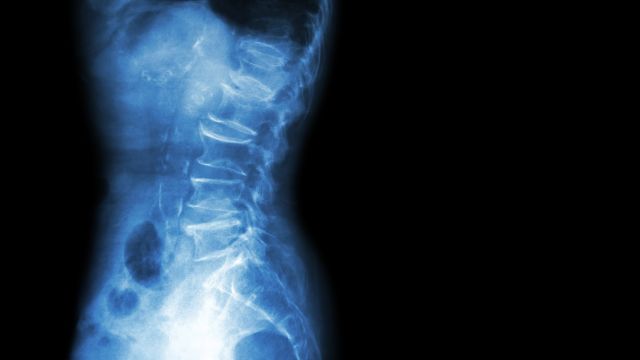If you have been diagnosed with osteoporosis, you know the weakening of bones increases the likelihood of getting a fracture. In the United States, more than 1.3 million people experience an osteoporosis-related fracture every year, making it a major public health concern. Although you cannot completely reverse osteoporosis, by making certain lifestyle changes, you can maintain or even improve your bone density.
Your diet can have a profound impact on osteoporosis, for the better or for the worse. The Ornish Program consists primarily of a whole-food plant-based diet that minimizes meat intake. This dietary combination may slow your rate of bone density loss as you age and decrease your risk for fracture.
Do you believe that osteoporosis is caused by a deficiency of calcium intake? In reality, it’s an imbalance between calcium intake and excretion. If you eat a whole-food plant-based diet you are actually significantly lowering your risk for osteoporosis despite consuming less calcium. The reason is that when you eat a lot of meat and dairy, you excrete more calcium, so the net effect is to leach calcium from your bones. That’s why those consuming a whole-food plant-based diet have lower rates of osteoporosis.
What are the risk factors for osteoporosis?
Many risk factors are associated with osteoporosis. The most common are listed here.
- Men and women 70 years and older have an increased rate of fracture.
- Northern European whites and Asians are at higher risk.
- Women are four times more likely than men to have osteoporosis.
- Thinner individuals tend to have lower bone density.
- Having a parent or sibling with a history of hip fractures and/or osteoporosis increases your risk for developing osteoporosis.
- Previous fracture as an adult.
- Smoking, excessive alcohol use, and sedentary lifestyle increase one’s risk for developing osteoporosis.
- Long-term use certain medications such as acid inhibitors used for digestive issues, oral steroids such as prednisone and certain antiepileptic drugs increase your risk for developing osteoporosis
- No history of bearing offspring.
- Early onset of menopause.
- Calcium or vitamin D deficiency.
If you have two or more of the above risk factors and are a woman younger than age 65, you may be a candidate for early screening for osteoporosis using a special scan that measures your bone mineral density to evaluate the thickness of your bones. Otherwise, it is recommended that all women aged 65 years and older, regardless of risk factors, be screened for osteoporosis.
What lifestyle changes can I make to improve my bone health?
There are many things you can do to prevent or slow the progression of osteoporosis.
Quit smoking: If you are a smoker, quit smoking as smoking contributes to calcium loss and decreases bone strength.
Exercise regularly. Consistent weight-bearing exercise (walking, jogging, dancing, playing tennis and lifting weights) helps keep your bones strong and decreases the likelihood of you getting a fracture if you fall.
Limit caffeine to one cup of coffee per day. Caffeine has a diuretic effect that causes your body to lose both water and calcium.
Limit your daily salt intake. Sodium, which is the primary ingredient in salt, increases urinary calcium loss. You can actually significantly decrease your daily calcium requirement by reducing your overall sodium intake. A few strategies include avoiding salty snacks, reading food labels carefully (especially canned foods) before purchasing a food item and eating home-cooked meals more frequently (restaurants tend to add a lot of salt to their food).
Limit your alcohol consumption (ideally no more than one drink per day). Alcohol can weaken bones when consumed in high quantities. One large study found that having more than 1.5 drinks per day can increase your risk for osteoporotic fracture by about 40 percent compared with someone who consumes less than this amount.
Reduce animal protein intake. Animal protein tends to leach calcium from the bones and lead to its excretion in the urine. Women with higher meat intake (at least five servings per week) have been shown to have a significantly increased risk for forearm fracture compared with women eating meat less than once per week.
Increase fruit and vegetable intake. Change up your diet. Increased fruit and vegetable intake is associated with higher bone mineral density in both men and women.(4,5) This is likely due to the bone-supporting effects of the vitamins and minerals they carry such as calcium, potassium, magnesium, vitamin K, and folic acid.
Consume adequate calcium and vitamin D. Men and premenopausal women need about 1000 mg of calcium (no more than 500 mg at a time due to limited absorption) and 800 to 1200 units of vitamin D daily. Postmenopausal women have slightly higher requirements: about 1500 mg of calcium and 1000 to 2000 units of vitamin D daily. Ideally, most of your calcium should come from your diet and vitamin D from your diet and the sun. The Ornish diet, which emphasizes nonfat dairy (yogurt, milk), leafy greens, tofu, and mushrooms, has enough calcium. If you are not meeting your daily requirements through diet alone, you can take a multivitamin or an over-the-counter calcium and vitamin D supplement. Also your should try to get 5 to 10 minutes of sun exposure every day before putting on sunscreen, as this helps your body to produce vitamin D.
With the exception of quitting smoking and exercising more, the lifestyle recommendations for preventing and treating osteoporosis are dietary. The Ornish Program consists primarily of a low-sodium plant-based diet that minimizes meat intake, a dietary combination that may slow your rate of bone density loss as you age and decrease your risk for fracture.
Looking for other ways to live a healthier, happier life? Reverse heart disease and diabetes, lose weight and reduce your cancer risk with these tips from Dean Ornish.
This content originally appeared on Ornish Living.






